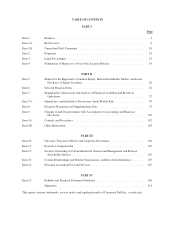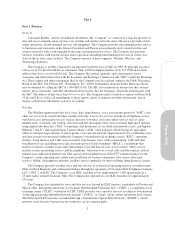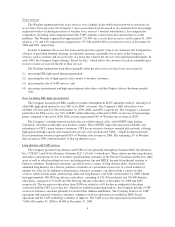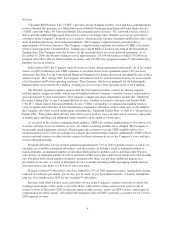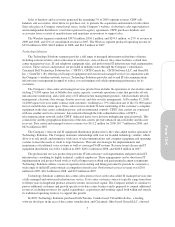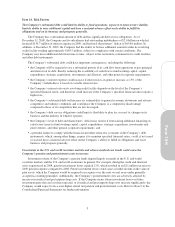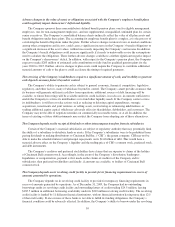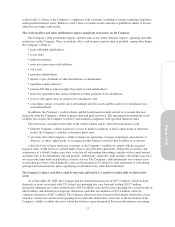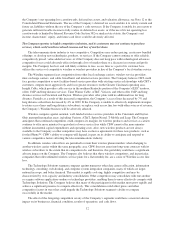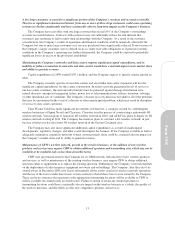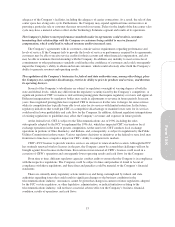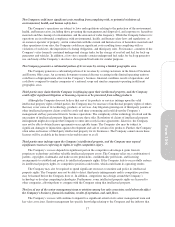Cincinnati Bell 2009 Annual Report Download - page 79
Download and view the complete annual report
Please find page 79 of the 2009 Cincinnati Bell annual report below. You can navigate through the pages in the report by either clicking on the pages listed below, or by using the keyword search tool below to find specific information within the annual report.
Item 1A. Risk Factors
The Company’s substantial debt could limit its ability to fund operations, expose it to interest rate volatility,
limit its ability to raise additional capital and have a material adverse effect on its ability to fulfill its
obligations and on its business and prospects generally.
The Company has a substantial amount of debt and has significant debt service obligations. As of
December 31, 2009, the Company and its subsidiaries had outstanding indebtedness of $2.0 billion on which it
incurred $130.7 million of interest expense in 2009, and had total shareowners’ deficit of $654.6 million. In
addition, at December 31, 2009, the Company had the ability to borrow additional amounts under its revolving
credit facility totaling approximately $185.5 million, subject to compliance with certain conditions. The
Company may incur additional debt from time to time, subject to the restrictions contained in its credit facilities
and other debt instruments.
The Company’s substantial debt could have important consequences, including the following:
•the Company will be required to use a substantial portion of its cash flow from operations to pay principal
and interest on its debt, thereby reducing the availability of cash flow to fund working capital, capital
expenditures, strategic acquisitions, investments and alliances, and other general corporate requirements;
•the Company’s interest expense could increase if interest rates, in general, increase as 15% of the
Company’s indebtedness is based on variable interest rates;
•the Company’s interest rate on its revolving credit facility depends on the level of the Company’s
specified financial ratios, and therefore could increase if the Company’s specified financial ratios require a
higher rate;
•the Company’s substantial debt will increase its vulnerability to general economic downturns and adverse
competitive and industry conditions and could place the Company at a competitive disadvantage
compared to those of its competitors that are less leveraged;
•the Company’s debt service obligations could limit its flexibility to plan for, or react to, changes in its
business and the industry in which it operates;
•the Company’s level of debt and shareowners’ deficit may restrict it from raising additional financing on
satisfactory terms to fund working capital, capital expenditures, strategic acquisitions, investments and
joint ventures, and other general corporate requirements; and
•a potential failure to comply with the financial and other restrictive covenants in the Company’s debt
instruments, which, among other things, require it to maintain specified financial ratios, could, if not cured
or waived, have a material adverse effect on the Company’s ability to fulfill its obligations and on its
business and prospects generally.
Uncertainty in the U.S. and world securities markets and adverse medical cost trends could cause the
Company’s pension and postretirement costs to increase.
Investment returns of the Company’s pension funds depend largely on trends in the U.S. and world
securities markets and the U.S. and world economies in general. For example, during the credit and financial
crisis experienced in 2008, pension investment losses equaled 23%, which resulted in an $11 million increase to
2009 pension expense compared to 2008. Future investment losses could cause a further decline in the value of
plan assets, which the Company would be required to recognize over the next several years under generally
accepted accounting principles. Additionally, the Company’s postretirement costs are adversely affected by
increases in medical and prescription drug costs. If the Company incurs future investment losses or future
investment gains that are less than expected, or if medical and prescription drug costs increase significantly, the
Company would expect to face even higher annual net pension and postretirement costs. Refer to Note 9 to the
Consolidated Financial Statements for further information.
9
Form 10-K





